Rare Disease Day 2021: Brighton teenager Will Pierce one of the oldest in the world with SCN2A
Will Pierce is one of the oldest people in the world with a rare disease that means he cannot walk, talk or eat without a tube.
News
Don't miss out on the headlines from News. Followed categories will be added to My News.
A Melbourne teenager that’s defied the odds to become one of the oldest in the world to live with a genetic mutation that leaves you unable to walk, talk or eat without a tube. A Sydney girl missing the middle area of her brain. An aspiring Sunshine Coast photographer with a deadly allergy to almost all foods. And a 22-month Adelaide boy whose life was cut short by a brutal disease.
These are the stories of brave young Australians with some of the rarest diseases in the world. Their families hope to raise awareness and lure funding into research and development in the lead up to Rare Disease Day, Sunday.
TEENAGER BEATING GLOBAL ODDS
At 19, Will Pierce has defied the odds by becoming one of the oldest people in the world known to be living with SCN2A. The teenager from Brighton in Melbourne is one of only 40 Australians with the devastating genetic mutation.
SCN2A is a change in the sodium channel in your brain: it can overproduce or underproduce. It causes severe disability and can ultimately cause early death. Will’s is overactive.
He was only properly diagnosed five years ago because of advancements in research. Prior to that doctors thought he had Alpers syndrome, a progressive neurological disorder.
“He was sick from birth: he had a catastrophic seizure and spent most of his first year in hospital. At the end of that he was sent home for palliative care; they thought that he would continue to get worse and he would die,” his mother Kris Pierce recalls.
“Slowly over time, within years, he started reaching some small milestones. He was smiling. He started to show signs of progression not regression”.
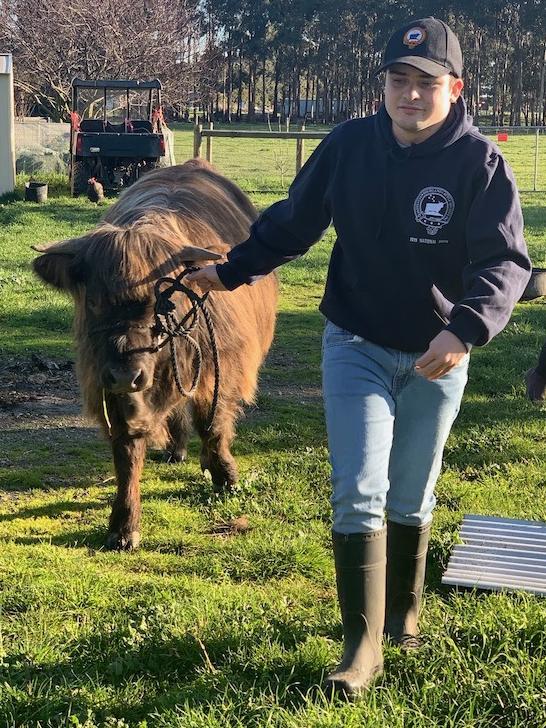
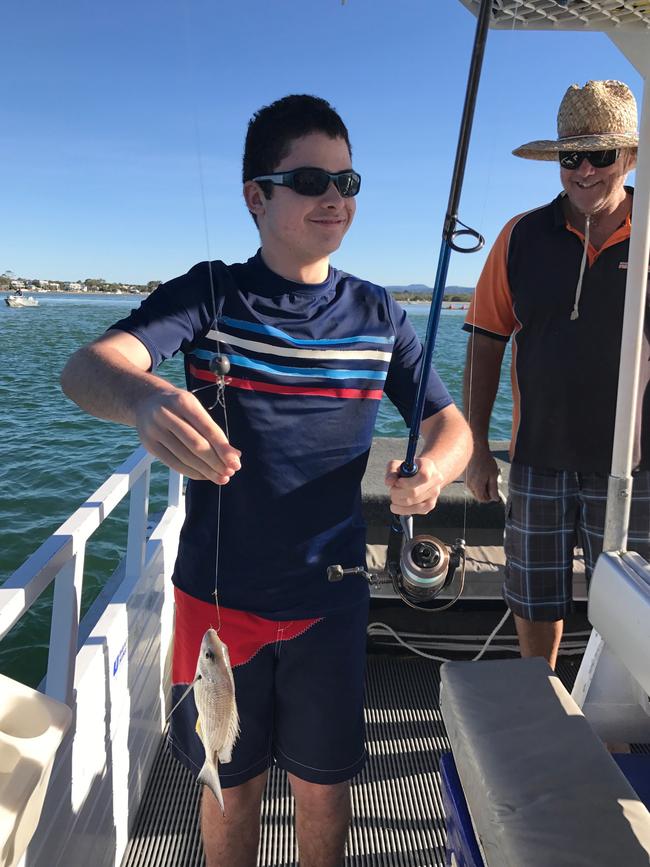
Will has intellectual and physical disabilities, autism and is non-verbal. He can fork feed himself but needs assistance to shower and brush his teeth. He simply can’t live independently.
As he is one of the oldest diagnosed with SCN2A there are not a lot of people to look at in terms of life trajectory.
For now he can still walk and is using whatever skills he has to pursue his dreams.
“Will is an amazing kid who has very strong passions about certain things. He has fallen in love with Highland cattle and he has this amazing ability to endear people to him and his passions,” Ms Pierce said.
He is so passionate about Highland cattle the Australian Highland cattle Society has taken him under their wing coaching him to show cattle at agricultural shows.
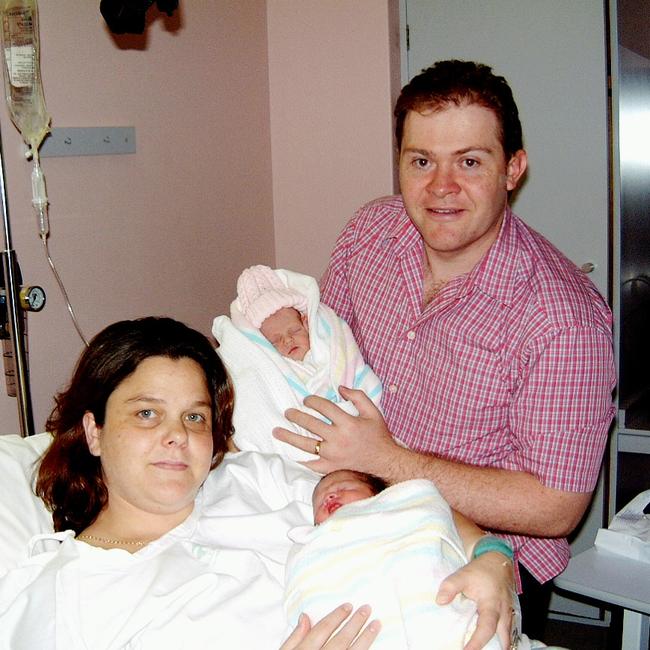
Ms Pierce said Will’s got his challenges, but that doesn’t stop him from chasing his dreams.
“He is the kid that reminds you to live your dreams. He has found his and he chases them,” she said.
She has founded the SCN2A Australia group to support other families with SCN2A and to advocate for better support including one rare complex epilepsy nurse in each children’s hospital around Australia.
She is also in talks with the government to streamline NDIS support for children with rare diseases.
“We don’t have a loud voice to be able to advocate. During Breast Cancer Awareness Day recently they were aiming to have 55 breast cancer nurses around Australia. I’m not saying that’s not necessary but we’re trying to get one rare complex epilepsy nurse in each state around Australia and to get a voice for that is impossible.
“These families are struggling. Their kids are so complex; if you ask them to list the specialists and therapists they see you’d need you two hands and your toes as well.” she said.
GIRL MISSING THE MIDDLE OF HER BRAIN
Angelina Moschoudis is a typical five-year-old girl.
She loves The Wiggles, song and dance and story time.
But unlike other kids her age the much-loved Sydney girl has something that sets her apart: she is missing the middle area of her brain.
Angelina has a rare congenital disorder called Agenesis of the Corpus Callosum (ACC). Put plainly, the section of the brain that connects the two cerebral hemispheres isn’t there. This is the control centre for higher neural functions including motor, sensory and cognitive functions.
It affects her ability to walk, talk, eat and control her emotions.
She also has Microcephaly, or small brain, a condition in which a child’s head is significantly smaller than the range of other children in the same age and gender.
The conditions are the result of the brain developing abnormally in the womb and not growing as it should after birth.
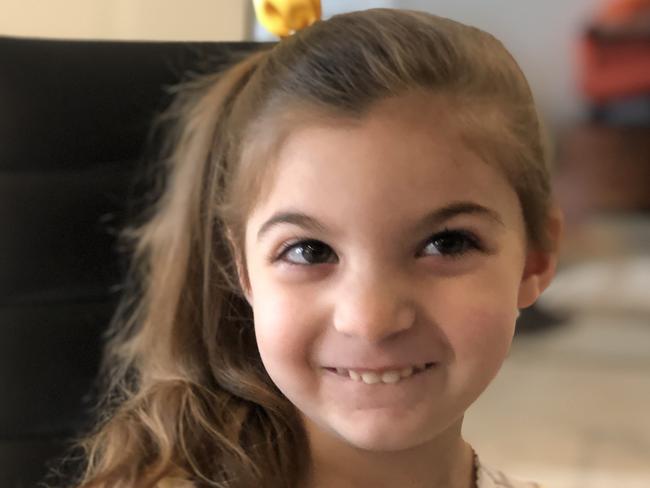
Genetic testing found Angelina’s brain abnormalities arise from a calcium/calmodulin-dependent serine protein kinase (CASK) gene mutation that has only recently been discovered and is a rare condition affecting only an estimated 50 children worldwide.
Her mother Giovi Moschoudis said her “little angel” has defied the odds by reaching milestones with the help of early intervention including physio, speech pathology, occupational therapy and swimming.
She took her first steps at three-and-a-half years old, and is now learning to walk on hills, stairs and other surfaces but her balance is affected so she falls over.
Angelina can say 105 words now – her mother proudly noting each one down – and she is learning both sign and being able to point to images to express what she wants in speech therapy. However, she can understand so much more than she can express.
The determined youngster is now just beginning to eat more solid foods like tiny pieces of sausages, mince, pasta and vegetables but feeding can take up to an hour or more. Being able to move the food, chew and swallow is complex for Angelina as it involves the motor movements and having adequate muscle strength.
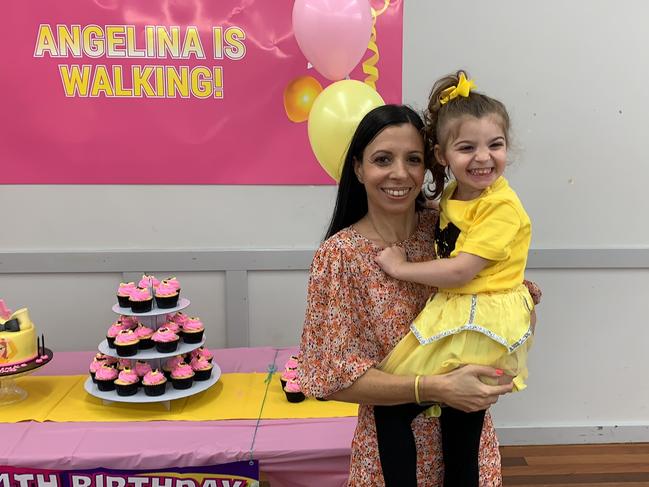
Mrs Moschoudis says the most difficult challenge at the moment is emotional control.
Cognitively Angelina is about two years old. She cannot control her emotions which results in meltdowns regularly.
“This has increased over the past 12 months and as she is getting stronger, it becomes harder to keep her safe when the meltdowns occur: there’s head banging, scratching walls, kicking the closest person to her. Ultimately, imagine being in a body and not being able to make it do what you want it to do.”
Despite all efforts, researchers in the US and Japan recently discovered Angelina’s condition is degenerative which means she may lose the skills that she has been trying so hard to achieve, being relegated to a wheelchair with no ability to communicate or eat unassisted other than through a tube.
Following this devastating news, her family set up the Angelina CASK Neurological Research Foundation with the main objective to find treatments and ultimately a cure to improve the quality of lives of all children and adults who have CASK.
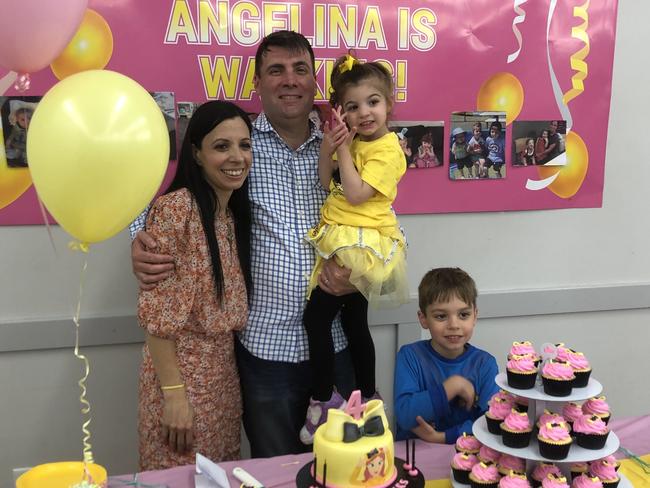
Angelina has an older brother Aydan, six, and two older step-siblings Ethan and Lili.
The impact has been profound not only on Mrs Moschoudis and her husband Charles but also Aydan and their respective families.
The emotional and physical demands that caring for a child with a rare disease such as Angelina’s “is indescribable”. But it’s also brought positives.
“My husband and I and our families no longer take simple moments for granted. Aydan has learnt to be compassionate and wants to help Angelina in every way and feels contentment like his father and I do every time she reaches a milestone no matter how small. This journey, as heartbreaking as some days are, also provides an inner-strength, a resilience and a completely different outlook to life and what matters. Hope and love for each other and Angelina’s smile, keeps us going.”
Mrs Moschoudis hopes Rare Disease Day, of which Angelina is this year one of the faces of the global campaign, will raise awareness about the condition and improve funding for research in the area.
“I understand common diseases are researched, because there are many (opposite to rare) and I think the underlying issue is they are more profitable. However, shouldn’t every child, adult, human being in this world matter and be given a chance at a better quality of life?”
BRUTAL DISEASE KILLED BABY BOY
Anna Pak Poy will never see her boy Sebby Coupar become a man.
There will be no memories of birthday parties, school graduations, and if he chose, a wedding day.
The Adelaide boy’s life was cut short at just 22 months by the neurological genetic disorder, Tay-Sachs disease.
Tay-Sachs is a rare disorder passed unknowingly from parents to child, unless parents are aware they are themselves a carrier. It’s caused by the absence of an enzyme that helps break down fatty substances. These fatty substances, called gangliosides, build up to toxic levels in the child’s brain and affect the function of the nerve cells.
Sadly it affects mainly children and life expectancy is no longer than four years.
Sebby died in March 2019, 15 months after being diagnosed with the condition.
Ms Pak Poy was pregnant with Sebby’s sister Layla when he passed away.
CVS testing at 11 weeks showed his sister has no copy of the gene.
“We miss Sebby every day. It is horrible,” Ms Pak Poy said.
“He was so charismatic. Before he was diagnosed he was hitting all his milestones, he was really engaged with everyone around him. My sister said ‘he collected people like treasures and put them in his pocket, and that’s where they stayed’; he was always in everyone’s heart and always is as well. He was really amazing.”
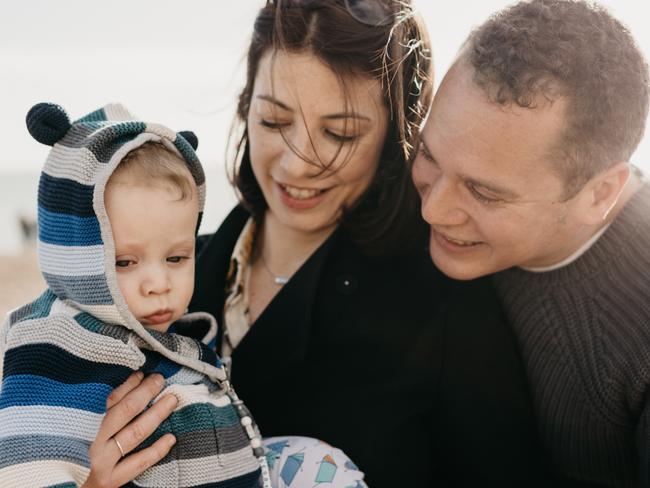
Tay-Sachs disease in infantile form sees babies regress in their milestones so they lose their ability to sit, if they had gained that ability to begin with, lose muscle tone, and get dystonia and a startle reflex.
From there the symptoms get worse, including seizures, vision and hearing loss, and loss of ability to eat or swallow.
“It’s really brutal, it’s very aggressive, and it can happen very quickly and because there is no cure it becomes all about managing the symptoms,” Ms Pak Poy said.
A child can only have Tay-Sachs disease if both parents are carriers of the gene. Both Ms Pak Poy and her husband Marc Coupar were unknowingly carriers.
She wants people planning to have babies to know that genetic screening is available.
“It doesn’t mean that you can’t have babies, it just means that you can make a decision on how to do it,” she said.
“It’s not the sort of thing that will show up on an ultrasound.”
Tay-Sachs has been known about for about 100 years, but there is no cure.
Ms Pak Poy set up the Rare Find Foundation to support other families with Tay-Sachs sufferers and advocate for more collaborative research to find treatments and cures for Tay-Sachs and Sandhoff diseases”.
“There is a lot of gene therapy showing promise but there is nothing at the moment,” she said.
“For us to be in the year 2021 and have landed the man on the moon and be doing gene editing and for my son to have died from Tay-Sachs disease is really horrific, it is unfathomable.”
QUEENSLAND GIRL ALLERGIC TO MOST FOODS
When Bella Gray was a baby she stopped growing. Nobody knew why.
At four months, she failed to thrive. She was breastfed for 13 months but her mother had to remove milk from her diet when Bella was seven months because she couldn’t tolerate dairy.
She was taken to several doctors and paediatricians with different opinions but nobody could explain why she wasn’t growing. Then at 18 months she was referred to a gastroenterologist for an endoscopy and was diagnosed with eosinophilic oesophagitis (EoE), an inflammatory condition of the oesophagus.
The aspiring Sunshine Coast photographer also lives with anaphylaxis risk allergies to egg, fish, chicken and dairy and suffers from asthma and eczema.
“With EoE certain foods trigger chest pain, they feel like they are getting stuck, there are swallowing problems and regurgitation. And then anaphylaxis is immediately life threatening; Bella has had several episodes over the years.”

There is no test that can reliably indicate EoE triggers and repeat endoscopies are required to monitor the disease and the effectiveness of treatment. For Bella, determining these triggers over the years was a long trial and error process and wheat, corn, peas and soy also needed to be avoided on her elimination diet.
When Bella was first diagnosed she started drinking an elemental formula but she couldn’t have enough to maintain her nutrition. From the age of seven she was tube-fed for 10 hours overnight for four years.
“During that time she could eat some foods but because she was allergic to so many things she was tube-fed,” her mother Sarah Gray said.
“Her hair started growing better, and she had energy to do things and even took up cheerleading as a sport.”
Now 17, Bella’s still small for her age but then she never was on the growth percentile chart.
She is finally off the formula but keeps a strict vegan diet as her food allergies persist.
Bella graduated from TAFE last year with a certificate in photography “but studying full time was a struggle”. She is looking for work now but only part time initially.
“It’s an invisible rare disease, you can’t tell what is going on from the outside, there is a lot of ongoing pain like chronic fatigue and mental health impact. Even trying to do something with her friends she can have one day but then needs a rest day.”
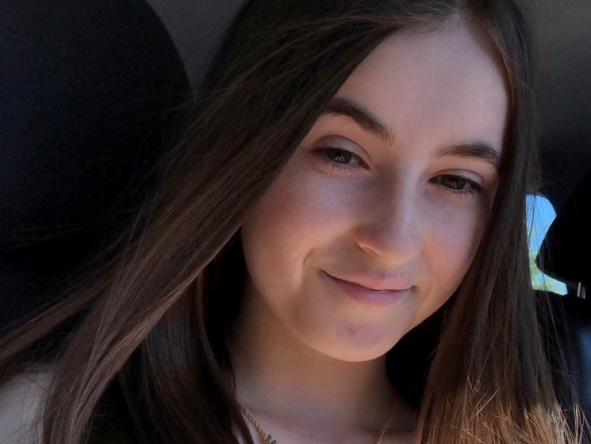
EoE is not a disease that is necessarily pointed to a lower life expectancy but it is a rare disease that is becoming more common. When Bella was diagnosed it was one in 10,000 but now the prevalence of EoE is one in 2000 and possibly becoming more than that.
Ms Gray founded ausEE to provide support to the estimated 12,000 Australians with EoE and to raise awareness about the condition. But more funding is needed.
“There is a genetic link to the disorder but we still don’t really know enough about it and we want to see more research into this condition.”
Government funding for the charity and sufferers is also scarce.
“We have no government support; I have been a volunteer running the charity for 11 years but we are not considered a priority area. For people with this life altering diagnosis it’s hard for them to get the support they need as eligibility varies greatly. There is a lack of knowledge of this complex condition and more support and understanding is crucial.”
The federal government’s National Disability Insurance Scheme funds costs associated with disability.
A spokesperson for the National Disability Insurance Agency which runs the program said independent assessments were introduced last year as a way of ensuring all eligible Australians with a disability are supported to apply for the NDIS.
“The tools and framework used for the assessment have been selected for their suitability in collaboration with experts in the sector. The tools are disability-neutral, so they can be used across all disability types,” an NDIA spokesperson said
The NDIA Quarterly Report data, to 31 December 2020, showed improvement in the time taken for people to access support including:
100 per cent access decisions made within 21 day time frame, consistent across the last year.
98 per cent first plans approved for participants aged 0-6 within 90 day time frame, compared to 85 per cent a year ago; and
92 per cent first plans approved for participants aged 7 and above within 70 day time frame, compared to 64 per cent a year ago.
Rare Voices Australia CEO Nicole Millis said the National Strategic Action Plan for Rare Diseases was launched in February 2020 in the lead up to Rare Disease Day. The Action Plan is the first nationally co-ordinated effort to address rare diseases in Australia.
“Rare Voices Australia led the collaborative development of the Action Plan and is now leading its collaborative implementation. The Action Plan will drive progress in key areas of awareness and education, care and support, and research and data. This will lead to the best possible health and wellbeing outcomes for Australians living with a rare disease.”
Find out more about Rare Disease Day 2021 at www.rarediseaseday.org





